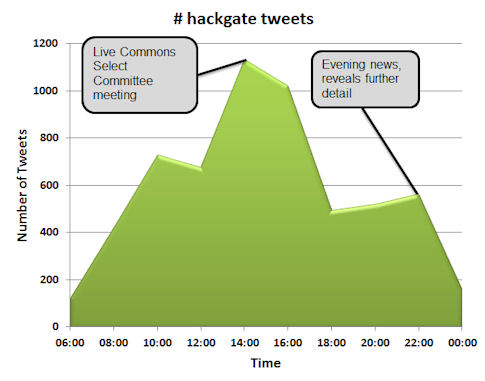From Facebook revolutionaries to Tweeting journalists, social media has had a dramatic impact on the making and breaking of news. A recent analysis by media intelligence specialist Precise of over one million Tweets by more than 3,700 UK journalists shows how they use Twitter to comment on current events. For example, journalists Tweeted vigorously about the News of the World’s alleged wrongdoings, with “Hackgate” – the summer’s most popular topic – generating a whopping 62,208 Tweets. “Riots” garnered 42,128 Tweets. The Middle-East uprisings, the Oslo shootings and Hurricane Irene were other hot Twitter topics this summer.
The graph below illustrates the use of #hackgate during a Commons Select Committee meeting on 19 July 2011.![]()
![]()

The peak at 2pm indicates that many journalists were following the live broadcast and Tweeting at the same time. The final spike at 10pm coincides with the evening news, which released more information about the investigation. Unsurprisingly, Rebekah Brooks was a Twitter celebrity, referenced in 12,114 Tweets by a total of 474 journalists.
Precise also tracked which newspapers were the most prolific Tweeters over the past three months. The Guardian came out on top with 30,297 journalist Tweets, followed by The Independent (14,786), The Daily Telegraph (14,377), The Times (13,540) and The Sun (10,067).
Reporters also use Twitter to source information. Precise found that the hashtag #journorequest was used 4,547 times by national newspapers and consumer magazines during the three summer months surveyed, with personal finance journalists accounting for 500 uses of the hashtag.
Twitter has fast become an essential tool for flacks and hacks and is changing how the two interact. PROs might still need to have lunch with a journalist, but engaging his or her Twitter feed at the right moment is just as important.
According to Keir Fawcus, managing director of Precise, “It’s helpful to understand journalist habits when it comes to Twitter. You have more chance of interacting with them early morning and around lunchtime than any other time, so be sure to target at the right moment.”
The same principles of old-school PR messaging also apply to Twitter – establishing credibility, relationship building and personalizing pitches. But timing and Twitter are even more intertwined.
Methodology
Precise analysed one million Tweets by more than 3,700 UK journalists between 1 June and 1 September 2011. Precise have recently launched TweetComms, an application which is designed to help PROs interact with journalists.
Written by Vivien Schweitzer
PR Masterclass: The Intersection of PR and GEO
Join PRmoment for a Masterclass featuring 10 of the industry’s foremost experts. You will walk away with a clear, actionable strategy for adapting your content to an AI-first search environment.
Taking place on Wednesday 25th February in London, both virtual and in person tickets are available.
Early bird ticket sale ends Friday 9 January.
PR MasterclassIf you enjoyed this article, sign up for free to our twice weekly editorial alert.
We have six email alerts in total - covering ESG, internal comms, PR jobs and events. Enter your email address below to find out more:









